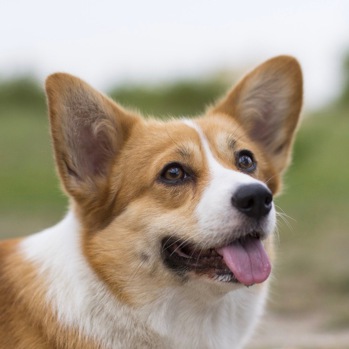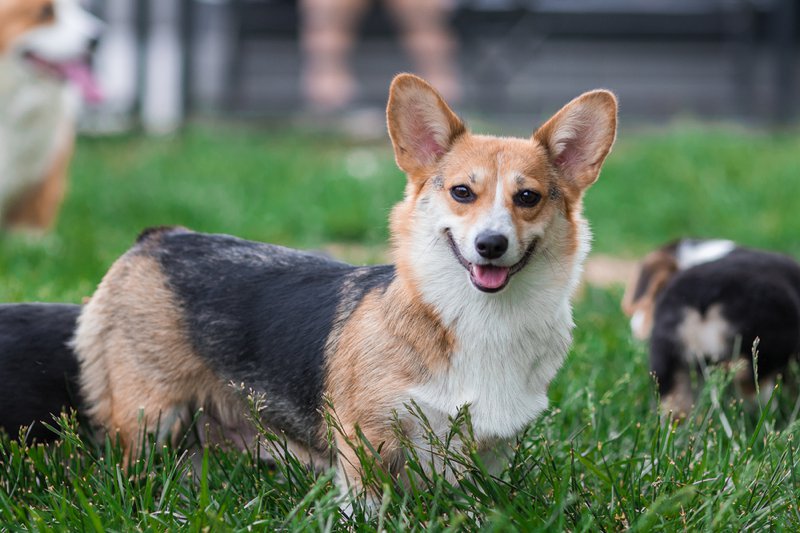Welsh Corgi

There are two different types of Welsh Corgi – the Cardigan Corgi and the Pembroke Corgi. The breeds were originally developed in Wales as working dogs for driving and herding cattle and guarding farms. Both are small dogs with a strong character, which are intelligent, affectionate and playful. The Cardigan Welsh Corgi is the slightly larger of the two and the coat colours, which are accepted for registration, vary between the two breeds. Both have a short to medium length, thick, dense coat that does not need professional grooming but can shed heavily so needs regular brushing at home.
The Welsh Corgi is loyal, affectionate and intelligent, meaning it is quick to learn and easily trained. Although small, the breed can have a big character, so firm and consistent training, along with socialisation from an early age, is essential. Both breeds need a medium amount of exercise and can be prone to becoming overweight, so ensuring they remain active is essential. The Cardigan and Pembroke Welsh Corgi are both fairly healthy breeds but can suffer from some health problems.
About & History
There are two different types of Welsh Corgi – the Cardigan Corgi and the Pembroke Corgi. Both breeds are small dogs that belong to the pastoral group of breeds and are considered vulnerable native breeds in the United Kingdom. The Cardigan Corgi is the older and larger of the two breeds, which were crossed freely until they were recognised as separate breeds by the UK Kennel Club in the 1930s. The Corgi was traditionally used for guarding, herding and driving cattle. They worked by nipping at the heels of the cattle in order to move them, and their small stature and agility allowed them to avoid being kicked.
Both Welsh Corgis are very old breeds and there are several different theories about their origins. Perhaps the most popular – it is claimed that the Cardigan Welsh Corgi was from the same group of dogs which Dachshunds were bred and that the Pembroke Welsh Corgi is related to a Spitz-type dog, which was introduced by the Celts. Both of these foundation breeds are thought to have been crossed with local Welsh Sheepdogs to produce the early ancestors of the Corgis we know today.
Today the Welsh Corgi is predominantly kept as a pet and companion. Their popularity has dropped in Britain and they are relatively rare, however, they have become more popular in America. Welsh Corgis are easily trainable and its working nature means that the breed can also excel in herding trials, obedience and other dog sports.
Appearance

The Cardigan Welsh Corgi and the Pembroke Welsh Corgi have a similar physical appearance with some differences predominantly to do with size and coat colours accepted for registration by the UK Kennel Club.
Welsh Corgi (Cardigan):
- Black Brindle & White
- Blue Merle
- Brindle
- Brindle & White
- Brindle Point Tricolour
- Red & White
- Red Brindle
- Red Brindle & White
- Red Point Tricolour
- Sable
- Sable & White
- Tricolour
Welsh Corgi (Pembroke):
- Red & White
- Sable & White
- Tricolour
The Welsh Corgi is a small dog with a tough and sturdy appearance. Both variations have long bodies relative to their height. The difference in desired weight and heights for the two different Corgi breeds is summarised in the following table:
| Height | Weight | |
|---|---|---|
| Cardigan Welsh Corgi | Ideally 30 cm | In proportion to size, should be balanced overall |
| Pembroke Welsh Corgi | 25 – 30 cm | 9 – 12 kg |
The Pembroke Corgi has a longer neck than the Cardigan Corgi, but both are muscular, leading to sloping shoulders. The front legs are short but strong with plenty of bone even down to the feet. Although the legs are short the body should not touch the ground. The breeds should have a broad, deep chest, leading to an obvious waist. The back should be straight and lead to strong, muscular back legs. Feet should be fairly large and rounded.
Both types of Welsh Corgi have a fox-like look to their face and head. They have a wide skull and long, pointy muzzle, which should be in a proportion of 3:5 with the head. They should have strong, healthy teeth and a perfect scissor bite. Their eyes should be wide set and medium sized with an alert look. The Cardigan Corgis ears should be large and the Pembroke Corgis should be of medium size; both should stand up straight.
The Corgi should have a free, active gait. The front legs should cover distance, with plenty of reach, whilst moving close to the ground and the back legs should provide plenty of drive.
Character & Temperament
Welsh Corgis are intelligent, very sociable and affectionate dogs with a strong but playful character. Despite their small size they have a big character and can often be wilful. They are usually very good with children – especially within their own family. They are very loyal and sometimes suspicious of strangers and are not ‘everyone’s’ dogs, often preferring people they know.
The Welsh Corgi makes an excellent watch dog, barking to warn of anything unusual. They should be well-socialized from puppyhood with other dogs to prevent anti-social behaviour and other animals, as they can be prone to chasing things if their herding instinct kicks in. Corgis do not typically suffer from separation anxiety, but like other dogs, should not be left alone for long periods of time.
Trainability

Both the Cardigan and Pembroke Corgi are intelligent dogs and learn very quickly. They have a working nature, and are also easily motivated by food, which can help with training. Corgis can have a strong character and be wilful so should not be mistaken as being like some other more easy-going small breeds.
This means they need firm and consistent training to ensure they do not become unruly and nippy. Early socialisation is also essential to ensure that they do not develop aggressive behaviours with other dogs. House training and training recall is not usually a problem and Corgis can excel in herding trials, obedience trials and agility.
Health
Both the Cardigan and Pembroke Corgis have an average life expectancy of between 12 and 15 years old and are classed as Category 1 breeds by the UK Kennel Club, with no specific points of concern. They are relatively healthy breeds but can still suffer from some diseases. Both breeds are achondroplastic, which accounts for their ‘dwarf’ stature and this can lead to specific conditions, such as:
Intervertebral Disc Disease (IDD)
The Corgis long back and short legs means they are more likely to suffer from back problems. Intervertebral discs in the spine degenerate faster than in non-chondrodystrophic breeds and this can cause IDD. IDD leads to pain and paralysis and often needs surgery, depending on the severity.
However, not all dogs recover and some may need to be put to sleep. Maintaining a healthy weight, with plenty of exercise, as well as avoiding stairs and jumping off beds, sofas and other furniture can help reduce the risk of IDD occurring.
Degenerative Myelopathy
This disease is progressive and affects the spinal cord in older dogs. Initially, it causes a loss of coordination in the back legs and this progressively becomes worse until the dog can no longer walk, eventually losing all control of its legs.
Unlike IDD, this condition is not painful and is often diagnosed by eliminating all other possibilities. Unfortunately, there is not currently any treatment available for degenerative myelopathy. A DNA test is available to identify dogs that carry a gene associated with the condition.
Hip Dysplasia
Hip dysplasia is caused by a combination of genetic and environmental factors and occurs when the hips develop abnormally. It can include several different developmental problems and abnormalities, which commonly lead to joint problems and arthritis later on in life. Dogs intended for breeding should have their hips x-rayed and scored by experts. The maximum score is 106 and the higher the score the more signs of hip dysplasia there are.
Progressive Retinal Atrophy PRA (rcd3)
PRA affects the retina and can include both developmental and degenerative diseases. Corgis are affected by a type of PRA, which occurs early on in life, gradually causing the retina to degenerate, thus causing dogs to lose their sight and eventually become blind.
Most dogs that suffer from this condition will become blind by 2 years of age. Participation in the British Veterinary Association (BVA) eye scheme is strongly recommended and the PRA test is mandatory for UK Kennel Club Assured Breeders of Cardigan Corgis.
Von Willebrand’s Disease
The Pembroke Corgi is specifically affected by Von Willebrand’s Disease. Dogs suffering from this condition lack a glycoprotein called Von Willebrand Factor that is necessary for normal blood clotting to occur. When this factor is absent from the clotting process any injury can cause excessive bleeding, as normal clotting does not occur. This disease is genetic.
Obesity
Both the Cardigan and the Pembroke Corgi can be prone to obesity. Becoming over weight can increase the chances of dogs being affected by intervertebral disc disease, so it is important they are not allowed to become obese. Feeding a suitable diet, avoiding titbits and ensuring dogs are well exercised can all help to combat obesity.
Exercise and Activity Levels
Although a relatively small dog, the Welsh Corgi was bred for herding as a working dog and is, in fact, very active. The Cardigan and Pembroke Corgi typically need at least an hour to an hour and a half of walking a day, but will happily carry on for much longer, as they were bred for endurance. At least some of this time should be spent off the lead to allow them to use plenty of energy, and potential owners should not be fooled into thinking they are a lap dog by their small stature.
Grooming
Both the Cardigan and the Pembroke Corgi have a thick, short-to-medium length coat, which has a hard texture. It is usually straight but extremely weather-proof and has an insulating undercoat. Neither breed requires any specialist grooming but their coats can shed heavily so regular brushing at home is needed to try and avoid excessive shedding around the house.
Famous Welsh Corgis
Some well-known examples of Corgis are:
- Linnet, Holly and Willow, Queen Elizabeth II’s Corgis
- Skipper from the film, Robinson Crusoe
- Zwei from the 3D series, RWBY
- Rufus, the first mascot of Amazon.com and his predecessor, Baxter
- Ein from the cartoon series, Cowboy Bebop
- Anna, Poppy, Alice, Megan & Oliver from the film, The Queen
- Ellen Mitchell from the film, Dave
- Lil’ Lightning from the film, 101 Dalmations II: Patch’s London Adventure
- Candy from the film, Little Dog Lost
- Edward from the film, The Accidental Tourist
- Elvis from the film, Don’t Tell Mom the Babysitter’s Dead
Cross-Breeds
There are numerous Corgi cross-breeds, some of these include:
- Dorgi – Cross between a Corgi and a Dachshund
- Corgipoo – Cross between a Corgi and a Toy Poodle
- Corgipom – Cross between a Corgi and a Pomeranian
- Shorgi – Cross between a Corgi and a Shih Tzu
- Porgi – Cross between a Corgi and a Pug
- Horgi – Cross between a Corgi and a Siberian Husky
- Sheporgi – Cross between a Corgi and a German Shepherd
- Dalcorgi – Cross between a Corgi and a Dalmatian
- Corgidor – Cross between a Corgi and a Labrador Retriever
- Corgherd – Cross between a Corgi and an Australian Shepherd
- Beagi – Cross between a Corgi and a Beagle
- Shigi – Cross between a Corgi and a Shiba Inu
- Chigi – Cross between a Corgi and a Chihuahua
- Corgiever – Cross between a Corgi and a Golden Retriever
- Rottgi – Cross between a Corgi and a Rottweiler
- Greygi – Cross between a Corgi and a Greyhound
- Pitgi – Cross between a Corgi and an American Pit Bull Terrier

